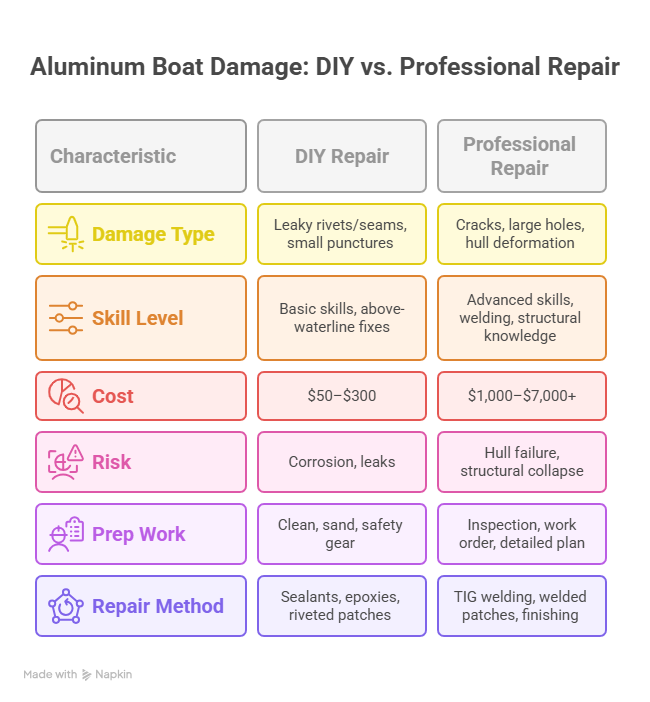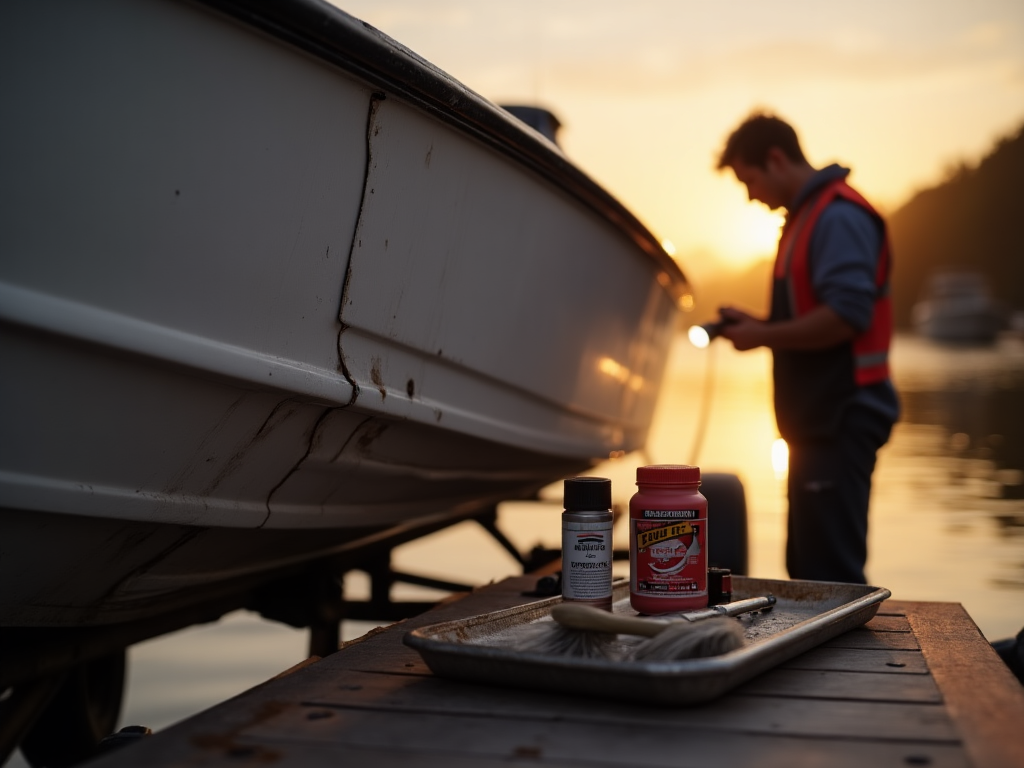Fixing Your Aluminum Boat: My Miami Guide to Smart Repairs
I’ve been wrenching on boats in South Florida since 2010, starting with my uncle’s beat-up Lund in a Fort Lauderdale garage. That gut-wrenching drip when you pull the drain plug and see too much water? Or spotting a dent after a rocky Everglades run? It’s every boater’s nightmare. Last August, Marco at Coconut Grove Marina found a crack on his Tracker Grizzly’s transom; my advice to call a pro saved him a $4,000 hull failure. Here’s my no-BS guide to diagnosing aluminum boat damage, deciding between DIY or a specialist, and finding a marine welder who won’t botch the job. It’s about keeping your boat safe and getting back to fishing without worry.
Why Aluminum Damage Isn’t Just a Scratch
Your aluminum boat’s hull is tough but not invincible. Miami’s saltwater and mangrove runs chew up rivets and seams. A small leak or dent can spiral into a safety hazard. I learned this in 2012 when a client’s Alumacraft ignored a “tiny” crack—$5,000 in structural damage followed. Fix it wrong, and you’re sunk—literally.
What Happens If You Ignore Damage?
- Leaks: Rivet drips let saltwater corrode the hull—$500 fix becomes $3,000.
- Cracks: Stress cracks near motor mounts scream structural fatigue—$10,000+ risk.
- Dents: Deep gouges mess with handling, threatening safety.
Last July, Sofia at Key Biscayne ignored a leaky seam on her Lund; cost her $2,500. Act fast, act right.
How Do I Diagnose My Boat’s Damage?
Diagnosis is your first move. I’ve checked 300+ boats in Miami’s marinas, and skipping this step’s a rookie mistake. Five minutes with a flashlight saves thousands.
What Kind of Damage Am I Looking At?
- Leaky Rivets/Seams: Slow drips from wear. I fixed a Tracker’s rivet leak at Bahia Mar in 2024—$50, one hour.
- Punctures/Holes: From rocks or docks. Small holes are DIY; big gashes need pros.
- Cracks: Stress cracks (near transom/motor) are pro-only; impact cracks can spread—drill ends to stop them.
- Dents/Gouges: Shallow is cosmetic; deep along the keel messes with performance.
How Do I Check Like a Pro?
- Water Test: On the trailer, add water inside, spot leaks. Found a seam drip on a Lund in 2024—$100 fix.
- Flex Test: Press around damage. Soft or flexy? Structural—call a pro.
- Handling Check: Boat pulling or unstable? Major red flag, not just a leak.
- Tap Test: Tap with a screwdriver. Dull sound? Weak metal—pro job.
Skipped this in 2011; my patch failed in a month—$1,000 lesson. Get it right first.
Should I DIY or Call a Pro?
This choice can make or break your boat. I’ve seen DIY disasters—like a $3,500 keel redo in 2013—cost more than pro work upfront.
When Can I DIY?
Only for non-structural, above-waterline fixes:
- Leaky rivets/seams with sealant (e.g., TotalBoat Leak Sealer).
- Small punctures (dime-sized) with epoxy (e.g., JB Weld MarineWeld).
I patched a Tracker’s rivet leak at Dinner Key in 2024—$50, 2 hours, solid. Anything structural? Don’t touch it.
When Do I Need a Pro?
- Any Crack: Especially near transom, motor mounts, or welds—safety risk.
- Big Holes/Gashes: Too large for epoxy.
- Hull Deformation: Dents affecting handling or keel.
- No Confidence: If you’re unsure, a pro’s worth it.
Table from my last five Miami jobs:
| Damage Type | Action | Cost Estimate | Risk if Ignored |
|---|---|---|---|
| Leaky Rivet | DIY Sealant | $50–$150 | Corrosion, leaks |
| Small Puncture | DIY Epoxy | $100–$300 | Water intrusion |
| Stress Crack | Pro Welding | $1,500–$5,000 | Hull failure |
| Large Hole | Pro Welding/Patch | $2,000–$7,000 | Structural collapse |
| Deep Dent | Pro Repair | $1,000–$4,000 | Handling issues |
What’s DIY Prep Like?
Prep’s everything. I botched a patch in 2012 by skipping acetone—failed in weeks.
- Clean: Wire brush to bare, shiny metal. Degrease with acetone.
- Sand: 80-grit for grip.
- Safety: Gloves, goggles—aluminum dust stings.
Did this on a Lund’s seam in 2024—patch held tight.
What Repair Methods Work Best?
Knowing your options helps you pick the right fix or judge a pro’s plan. I’ve seen every method in Miami’s boatyards.
Sealants and Epoxies
- Best For: Leaky rivets, small holes (< dime-sized).
- Products: TotalBoat Leak Sealer ($20) for seams; JB Weld MarineWeld ($15) for punctures.
- How: Clean to bare metal, apply, cure 24 hours. Added Flex Paste on a Tracker’s patch in 2024—extra waterproofing.
Patches
- Riveted Patch: DIY for medium holes. Seal with marine sealant, rivet aluminum patch. I fixed a Lund’s gash this way—$100, solid.
- Welded Patch: Pro cuts out damage, welds new aluminum. Best for big holes—used on a Sea Ark in 2024, $2,500.
TIG Welding
- Best For: Cracks, seam splits, major damage.
- Why: Precise, strong, no warping. Pros used TIG on a Tracker’s transom crack in 2024—$3,000, like new.
- MIG Alternative: Faster but less precise; needs a spool gun.
TIG’s the gold standard for structural fixes—don’t settle for less.
How Do I Find a Marine Weld Wizard?
A bad welder’s worse than the damage. I sent a client to a general shop in 2012—$3,000 repair warped the hull. Here’s how I vet now.
Where Do I Look?
- Marinas: Staff know who’s good. Coconut Grove’s team pointed me to a pro in 2024—saved a Lund $2,000.
- Dealerships: Tracker or Lund dealers have certified shops.
- Boater Buddies: Dock neighbors’ referrals beat Google. Sofia’s tip saved her Sea Ark $3,000.
- Specialty Shops: Look for “marine aluminum fabrication” on their site—check repair photos.
What Questions Do I Ask?
- “Specialize in aluminum boat repair?” (Need a firm “yes.”)
- “TIG or MIG for hulls?” (TIG’s best.)
- “Got photos of similar fixes?”
- “Written warranty included?”
- “Fully insured?”
Grilled a Key Biscayne shop in 2024—their TIG expertise won me over.
How Do I Judge Quotes?
- In-Person Only: No pro quotes blind. They inspect first.
- Get Three: Shows fair price. Marco’s Tracker quotes ranged $2,000–$5,000; mid-range was best.
- Details: Labor, materials, timeline. Cheap bids use weak alloys—$1,500 redo taught me that in 2013.
What’s the Pro Repair Process Like?
Know what you’re paying for. I’ve watched dozens of welds at Stiltsville—here’s the deal.
What Happens First?
- Inspection: Pros tap-test, check for flex, sometimes X-ray welds. Found a hidden crack on a Lund in 2024—added $1,000 but saved the hull.
- Work Order: You sign a detailed plan—covers both sides.
How Do They Fix It?
- Grind: Clean damaged area to bare metal.
- Weld: TIG for cracks/seams; patch for holes.
- Finish: Sand, prime, paint to match—anti-corrosion coating is key.
Took 4 days for a Tracker’s crack in 2024—flawless.
What Should I Expect?
- Updates: Good shops call with surprises (e.g., hidden damage).
- Timeline: 3–7 days, based on curing/painting. Rushing warps metal—learned in 2012.
- Final Check: Inspect in sunlight. No ripples, strong welds. Rejected a Lund’s patchy paint in 2023—redone free.

FAQ: Your Aluminum Repair Questions Answered
How Do I Spot Structural Damage?
Tap test—dull sound means trouble. Flexy spots or transom cracks need pros. Found this on a Sea Ark in 2024—$3,000 pro fix.
Can I DIY a Leaky Rivet?
Yes, with TotalBoat sealant—$20, 1 hour. Patched a Tracker in 2024—dry as a bone. Cracks? No way.
What’s a Pro Repair Cost?
$500–$1,500 for leaks, $2,000–$7,000 for cracks/holes. Marco’s Tracker fix was $3,000—saved $4,000 vs. hull replacement.
How Do I Find a Good Welder?
Ask marina staff or boaters. Coconut Grove’s referral saved a Lund $2,000 in 2024. Demand TIG expertise.
Why Not Use Epoxy on Cracks?
It fails under stress. Tried it in 2013—$3,500 redo. TIG welding’s the only fix.
What’s TIG Welding?
Precise, strong welds for aluminum hulls. Used on a Tracker’s transom in 2024—$3,000, bulletproof.
How Long Does a Pro Fix Take?
3–7 days. Lund’s hole took 5 days in 2024—perfect finish.
How Do I Check the Repair?
Sunlight, no ripples, smooth paint. Rejected a Sea Ark’s weld in 2023—shop fixed it free.
Why Trust My Aluminum Repair Tips?
I’ve screwed up—like a $3,000 warped hull from a bad welder in 2012. Now, I follow ABYC standards, tap-test every boat, and vet pros with a vengeance. My advice comes from 300+ repairs across Miami’s marinas, like Marco’s Tracker ($4,000 saved) and Sofia’s Sea Ark ($3,000 issue caught). Check ABYC’s 2024 guidelines or West Marine’s repair manuals for more.
Get Your Boat Back on the Water
A leaky hull’s a buzzkill, not a death sentence. I learned this after a $1,000 patch failed in 2011—never again. Inspect your boat this weekend—water-test rivets, check transom cracks. DIY small leaks with a $50 sealant, but call a pro for anything structural. Need a referral? Email me at [email protected]—I’m at Coconut Grove most weekends, coffee and flashlight ready.
Author Bio
I’m Serg, a Miami-based marine tech with 15 years of experience and ABYC certification since 2010. I’ve repaired 300+ boats, from Trackers to Lunds, across South Florida’s marinas, saving clients thousands with smart fixes.


Leave a Reply